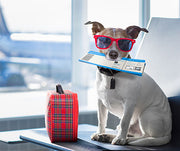Tips For Selecting Dog Toys

Here are some tips for selecting dog toys that cover a wide range of considerations and provide a valuable resource for pet parents of dogs seeking to enrich their pets’ playtime experiences. Here are a few additional tips and considerations that might complement your excellent guide:
Tips
- Supervise Playtime: Always supervise your dog during playtime, especially with new toys. This ensures their safety and allows you to monitor how they interact with the toy. Every dog plays differently so it’s always best to keep a close watch on your pup in case things get rough. Supervised play will help toys last longer and most importantly keep your pal safe.
- Rotate Toys: Keep a variety of toys on hand and rotate them regularly. Dogs can get bored with the same toys, so introducing new ones or bringing back “old” ones can reignite their interest. Petmate® offers a wide variety of dog toys suited for different types of play from Chuckit!®, JW®, HyperPet, Pet Qwerks®, Bark Bone, and Fat Cat
- Understand Your Dog’s Play Style: Dogs have different play styles—some love to chew, others enjoy fetching, and some prefer interactive play. Observe your dog’s preferences and tailor your toy selection to match their play style.
- Washable Toys: Opt for toys that are easy to clean such as the Chuckit® Ultra Ball®. Machine-washable or dishwasher-safe toys can help maintain a hygienic play environment for your dog.
- DIY Toys: Get creative with DIY toys. For example, you can stuff a JW Hol-ee Roller Dog Toy JW® Hol-ee Roller Dog Toy with treats or a JW® Ho-ee Bone Puzzle Dog Toy that can be turned into a fun treat-ee toy by stuffing it with kibble or peanut butter into the grooves of the toy.
- Monitor Wear and Tear: Regularly check your dog’s toys for signs of wear and tear. If a toy starts to break apart or has small pieces that could be swallowed. No dog toy is truly indestructible, so always remove the toy from playtime if pieces begin to break off replace it immediately.
- Temperature Considerations: Be mindful of the weather when choosing toys. In hot weather, avoid toys that can become uncomfortably hot in the sun. In colder weather, choose toys that won’t become brittle.
Considerations for Specific Dog Breeds:
- Strong Chewers: If you have a strong chewer, look for toys designed for durability like ones from Bark Bone. Brands that specifically cater to powerful chewers often offer reinforced and tough toys.
- Intelligent Breeds: Intelligent breeds benefit from puzzle toys like the JW® Tumble Teeez that challenge their minds. These toys often dispense treats as a reward for solving the puzzle, providing both mental stimulation and a tasty incentive.
- Energetic Breeds: Energetic breeds may benefit from toys that encourage physical activity, such as fetch toys like the Chuckit! Giggle Fetch or Pet Qwerks® Jingle X-Tire is designed for interactive play between you and your dog.
- Anxious Dogs: For anxious dogs, consider calming toys, such as plush toys such as the Zoobilee® Hedgehog Squatters, or toys that can be frozen to provide relief for teething or hot days like the JW® Puddle Stone Pop.
Special Considerations for Puppies:
- Teething Toys: Puppies go through a teething phase. Provide them with appropriate teething toys like the JW® Puppy Connects Soft-ee™ to soothe their gums and discourage inappropriate chewing.
- Soft Plush Toys: Opt for softer plush toys for puppies like the Pet Qwerks® Krinkle & Squeaky Newspaper Plush Dog Toy. These are gentler on their developing teeth and provide comfort during the early stages of crate training.
- Size-Appropriate Toys: Ensure that the toys you choose are suitable for the size and breed of your puppy. Avoid toys with small parts that could be swallowed.
By incorporating our tips for selecting dog toys will you become even more aware of the diverse needs and preferences of different dogs when it comes to their toys.
Previous article

Next article

Related posts
View all-

How to Train Your Dog in 2026: A Practical, Step-by-Step Guide
-

Keep Your Pets Safe During the Holidays
The holiday season brings joy, festivities, and a break from the usual routine. While you're enjoying the celebrations, it's important to remember that the holidays can present unique challenges for our furry family members. The new sights, sounds, and people can be overwhelming, and common festive items can pose unexpected risks.
Read Article -

Holiday Gifts for Every Pet Personality: The Ultimate Guide
The holiday season is finally here, and for many of us, that means finding the perfect presents for the ones we love most—our pets. Whether they are a steadfast dog who never leaves your side or an independent cat who graces you with their presence on their own terms, our pets are cherished members of the family. They deserve to celebrate right alongside us, stocking stuffers and all.
Read Article



